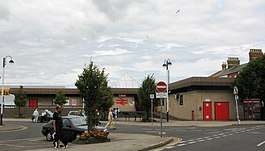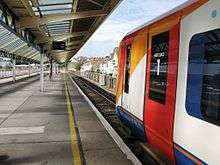Weymouth railway station
Weymouth railway station is the main railway station serving the town of Weymouth in Dorset, England (the other being Upwey station which is located north of the town centre). The station is the southern terminus of both the South Western Main Line, 142 miles 64 chains (229.8 km) down the line from London Waterloo, and the Heart of Wessex Line from Bristol Temple Meads and Gloucester.
| Weymouth | |
|---|---|
 | |
| Location | |
| Place | Weymouth |
| Local authority | Dorset |
| Coordinates | 50.616°N 2.455°W |
| Grid reference | SY679797 |
| Operations | |
| Station code | WEY |
| Managed by | South Western Railway |
| Number of platforms | 3 |
| DfT category | C1 |
| Live arrivals/departures, station information and onward connections from National Rail Enquiries | |
| Annual rail passenger usage* | |
| 2014/15 | |
| 2015/16 | |
| 2016/17 | |
| 2017/18 | |
| 2018/19 | |
| – Interchange | 6,117 |
| History | |
| Original company | Wilts, Somerset and Weymouth Railway |
| Pre-grouping | Great Western Railway |
| Post-grouping | Great Western Railway |
| 20 January 1857 | Opened |
| National Rail – UK railway stations | |
| * Annual estimated passenger usage based on sales of tickets in stated financial year(s) which end or originate at Weymouth from Office of Rail and Road statistics. Methodology may vary year on year. | |
_Station%2C_with_an_express_to_Waterloo_geograph-2635809-by-Ben-Brooksbank.jpg)
History
The Wilts, Somerset and Weymouth Railway, which was authorised in 1845, was built in stages (during which the company was absorbed in 1850 by the Great Western Railway).[1][2] Two of the last sections, from Yeovil Pen Mill to Weymouth and a connecting curve from that line to the Dorchester station of the London and South Western Railway (LSWR), were opened on 20 January 1857.[3] The LSWR was granted running powers from Dorchester to Weymouth,[4] where some of the platforms were dedicated for LSWR use; these powers were exercised from the opening day.[3][5] The station was named Weymouth, although some timetables showed it as Weymouth Town.[6] Branches to Portland and Weymouth Quay (both opened in 1865) ran from Weymouth Junction, just north of the station.[7]
The original station buildings were designed by TH Bertram and constructed in timber with a glazed overall roof across the tracks; this was removed after WW2. By the turn of the century the station area comprised five platforms, a large goods yard, and a small LSWR engine shed; the GWR had a larger shed situated north of the station. Nearby, Melcombe Regis served Portland passenger trains until 1952 and provided an overflow platform for excursion trains on busy summer weekends until 1959.
After the Second World War, the station saw rapid growth in holiday and Channel Islands traffic. As a result, the station underwent a major expansion in the late 1950s, gaining two lengthy excursion platforms (which now serve today's station), additional sidings adjacent to Jubilee Gardens, and a new signal box to replace two older boxes. However traffic soon declined and the station was progressively rationalised after the end of steam-hauled operations in 1967 with the goods yard closing in 1972 and the signal box and most of the remaining sidings being taken out of use in 1987. Although the current station is a mere shadow of its former self, the extension of third-rail electrification from Bournemouth in 1988 has given the station much improved services to London.
The current station building was formally opened on 3 July 1986; in its final years, the old Weymouth station was far too big for the traffic it was handling.
Accidents and incidents
- On 4 August 1868, a passenger train collided with the buffer stops at Weymouth due to poor rail conditions and driver error. Six people were injured.[8]
Services

South Western Railway operates a twice-hourly service to London Waterloo via Basingstoke.[9] Great Western Railway operate services every two hours via Westbury to Bristol Temple Meads and points north (e.g. Bristol Parkway and Gloucester).[10] There is an additional service running once or twice on a Saturday to London Waterloo via Salisbury operating from late May to early September each year.
| Preceding station | Following station | |||
|---|---|---|---|---|
| Upwey | South Western Railway London Waterloo to Weymouth via Southampton |
Terminus | ||
| South Western Railway London Waterloo to Weymouth via Yeovil (Summer Saturdays Only) |
||||
| Great Western Railway Heart of Wessex Line |
||||
| Dorchester West | Great Western Railway Weymouth Wizard (Summer Saturdays Only) |
Terminus | ||
| Disused railways | ||||
| Terminus | Great Western Railway Weymouth Harbour Tramway |
Weymouth Quay | ||
| Terminus | GWR and LSWR Portland Branch Railway |
Melcombe Regis | ||
| Historical railways | ||||
| Radipole Line open, station closed |
Great Western Railway Wilts, Somerset and Weymouth Railway |
Terminus | ||
Weymouth Quay
Weymouth Quay railway station is a disused terminus in the town. Its passenger station was used solely for trains connecting with cross-channel ferries, which have not run since 1987, though the line remains part of the network and the station, in theory, still open. Its use had been suggested as part of the transport infrastructure for the 2012 Olympic sailing events to take place on the Isle of Portland, though since it is accessed via the Weymouth Harbour Branch, which runs along public streets, this posed difficulties. Previously, the branch saw both freight and passenger traffic, most recently fuel-oil trains.[7]
Notes
- James 1983, p. 55.
- MacDermot 1927, pp. 278, 280, 285–7, 395.
- MacDermot 1927, p. 413.
- MacDermot 1927, p. 396.
- Williams 1968, p. 65.
- Butt 1995, p. 247.
- Catford, Nick (30 July 2013). "Weymouth Quay". Disused Stations. Retrieved 9 March 2016.
- "London and South Western Railway" (PDF). Board of Trade. 21 August 1868. Retrieved 21 March 2017.
- GB eNRT 2015-16 Edition, Table 158
- GB eNRT 2015-16 Edition, Table 123
References
- Butt, R.V.J. (1995). The Directory of Railway Stations. Yeovil: Patrick Stephens Ltd. ISBN 1-85260-508-1. R508.CS1 maint: ref=harv (link)
- James, Leslie (November 1983). A Chronology of the Construction of Britain's Railways 1778-1855. Shepperton: Ian Allan. ISBN 0-7110-1277-6. BE/1183.CS1 maint: ref=harv (link)
- MacDermot, E.T. (1927). History of the Great Western Railway, vol. I: 1833-1863. Paddington: Great Western Railway.CS1 maint: ref=harv (link)
- Williams, R.A. (1968). The London & South Western Railway, volume 1: The Formative Years. Newton Abbot: David & Charles. ISBN 0-7153-4188-X.CS1 maint: ref=harv (link)
| Wikimedia Commons has media related to Weymouth railway station. |
| This station offers access to the South West Coast Path | |
|---|---|
| Distance to path | ¼ mile (500 metres) |
| Next station anticlockwise | Swanage 48 miles (77 km) |
| Next station clockwise | Exmouth 76 miles (122 km) |